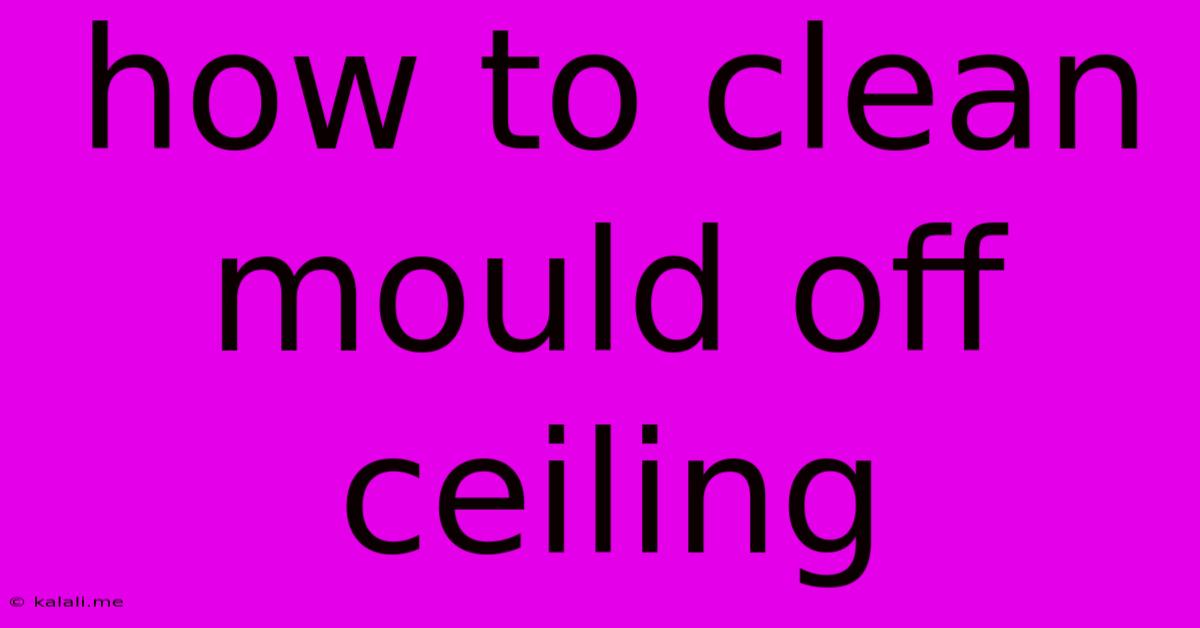How To Clean Mould Off Ceiling
Kalali
Jun 04, 2025 · 3 min read

Table of Contents
How to Clean Mold Off Your Ceiling: A Comprehensive Guide
Mold on your ceiling is not just unsightly; it's a potential health hazard. This guide provides a step-by-step approach to safely and effectively remove mold from your ceiling, minimizing the risk of re-growth and protecting your health. Remember, for extensive mold infestations, professional remediation may be necessary.
Understanding Ceiling Mold: Before you start cleaning, it's crucial to understand why mold grows. Moisture is the primary culprit. Leaks, high humidity, and poor ventilation all contribute to mold growth. Identifying and fixing the source of moisture is vital to prevent future mold problems. Common types of mold found on ceilings include Cladosporium, Aspergillus, and Penicillium.
Safety First: Essential Precautions
Mold removal involves working overhead, which can be physically demanding and risky. Before you begin:
- Protect Yourself: Wear protective gear including gloves, eye protection, a respirator mask (specifically an N95 or higher rated for mold spores), and old clothes you don't mind getting dirty.
- Ventilate the Area: Open windows and doors to maximize airflow and minimize spore dispersal. Use fans to help circulate air.
- Gather Your Supplies: You'll need a sturdy ladder, a spray bottle, cleaning solution (details below), scrub brushes (soft and stiff), sponges, microfiber cloths, a bucket, and possibly a shop vacuum with a HEPA filter.
- Test a Small Area: Before applying any cleaning solution to the entire affected area, test it on a small, inconspicuous spot to check for any discoloration or damage to the ceiling.
Choosing the Right Cleaning Solution:
For most mold situations, a simple solution is effective:
-
Diluted Bleach Solution: Mix one part bleach with ten parts water. Never mix bleach with ammonia or other cleaning products. Bleach is effective against many types of mold but can damage certain materials. Always test in an inconspicuous area first.
-
Vinegar Solution: White vinegar is a natural mold killer. Use undiluted white vinegar or a solution with equal parts water and vinegar. Vinegar is less harsh than bleach but might not be as effective against stubborn mold.
Step-by-Step Mold Removal Process:
-
Assess the Damage: Determine the extent of the mold infestation. Small patches can usually be handled with DIY methods, while larger areas may require professional help.
-
Prepare the Area: Cover the floor below the affected area with drop cloths to protect it from dripping water and mold spores.
-
Apply the Cleaning Solution: Using your spray bottle, thoroughly saturate the moldy area with your chosen cleaning solution. Allow it to sit for 10-15 minutes to penetrate the mold.
-
Scrub the Mold: Using a soft-bristled brush, gently scrub the mold. For stubborn mold, use a stiff-bristled brush, but be careful not to damage the ceiling surface.
-
Rinse and Wipe: Use clean water and a sponge to rinse the area thoroughly. Wipe away excess water with microfiber cloths.
-
Dry the Area: Use fans to help dry the area quickly. Proper drying is essential to prevent mold regrowth.
-
Dispose of Materials: Carefully dispose of all cleaning materials and rags in sealed plastic bags to prevent the spread of mold spores.
Preventing Future Mold Growth:
Preventing mold is far easier than removing it. Here are some essential steps:
- Fix Leaks: Address any leaks promptly to eliminate moisture sources.
- Improve Ventilation: Ensure adequate ventilation in bathrooms, kitchens, and other areas prone to moisture buildup. Use exhaust fans.
- Reduce Humidity: Use a dehumidifier to lower humidity levels, especially during humid seasons.
- Regular Cleaning: Regularly clean your ceiling to prevent mold from taking hold.
When to Call a Professional:
If the mold infestation is extensive, you notice unusual symptoms (allergies, respiratory problems), or you're unsure how to handle the situation safely, it's best to contact a professional mold remediation specialist. They have the expertise and equipment to handle large-scale mold problems safely and effectively. Remember, your health is paramount.
Latest Posts
Latest Posts
-
How Many Years Is Life In Prison In Georgia
Jun 06, 2025
-
Bg3 Which Classes Give Extra Attack And Bonus Attack
Jun 06, 2025
-
How To Block Event Invited On Iphone
Jun 06, 2025
-
How To Get Icloud To Only Save Favorite Photos
Jun 06, 2025
-
How Many Combinations With 9 Numbers
Jun 06, 2025
Related Post
Thank you for visiting our website which covers about How To Clean Mould Off Ceiling . We hope the information provided has been useful to you. Feel free to contact us if you have any questions or need further assistance. See you next time and don't miss to bookmark.